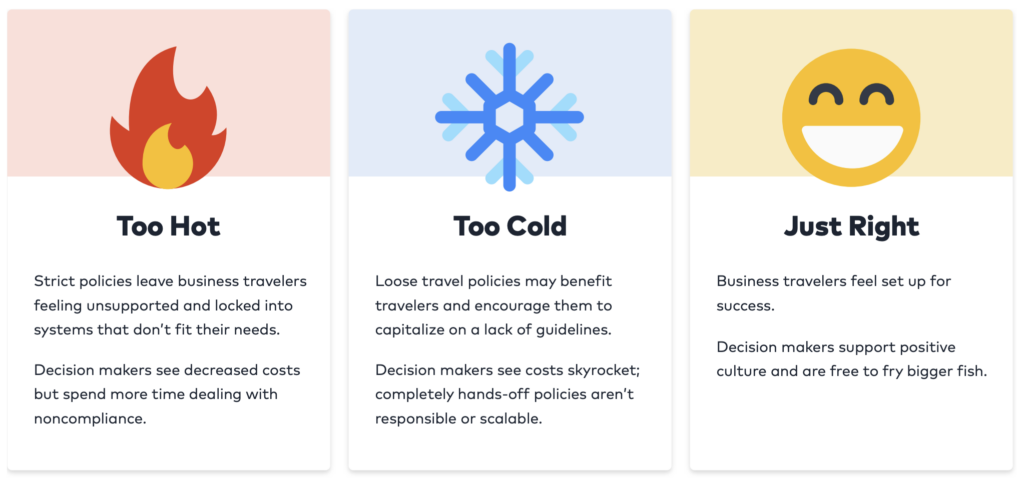T&E Policy Best Practices: 9 Easy Policy Updates that Rein in Costs
Creating a travel and expense (T&E) policy isn’t the hard part—getting people to follow it is. From confusing PDFs buried deep in your Intranet, to outdated reimbursement rates, and unclear guidance in high-stress travel chaos, it’s easy for even well-meaning employees to slip up. In this post, we share 9 simple T&E policy best practices to modernize your policy, make it more accessible, and align it with emerging spend patterns.
Table of Contents
1. Make Your T&E Policy More Accessible
If employees can’t find your policy, they can’t follow it. Many companies bury policies deep on shared drives or Intranets, in employee handbooks, or in onboarding paperwork. But adults learn by repetition. Make your policy inescapable, so employees always know where to reference it while booking travel or creating expense reports.
Actions to take:
- Pin your policy in Slack/Teams channels (e.g. travel, HR, finance)
- Link in internal email signatures (especially for HR, finance, managers)
- Embed in employee handbooks, onboarding, and training materials
- Attach to automated T&E emails (e.g. trip approval, reimbursement)
- Create a one-pager or TL;DR version of the policy for quick reference
2. Review and Update the Policy Regularly
Pricing and travel behaviors evolve. So should your policy. General merchandise retailers like Amazon are now expensed far more than meals, hotel stays and flights. But when we polled the CFO Leadership Council, most attendees did not have a clear policy for general retailers like Amazon.

Actions to take:
- Review new policies quarterly.
- Review established policies annually, at a minimum. Update for:
- IRS mileage reimbursement rates
- Travel cost trends
- Emerging merchant categories (such as Amazon, DoorDash, etc.)
- Employee feedback or pain points
3. Use T&E Software
Many finance and accounting teams are the leanest part of their organization. They don’t have the bandwidth to constantly chase receipts or audit bookings. Automated expense management software saves time, enforces rules in real-time, and provides detailed visibility.
Actions to take:
- Use T&E management software to:
- Build realistic trip estimates
- Enforce spending caps
- Flag violations at booking or expense submission
- Collect reason codes for out-of-policy spending
- Auto-route for manager approval
>> Related: T&E Policy Failures Are Costing You—Fix Them Fast <<
4. Set Realistic, Dynamic Budget Guidelines
Prices fluctuate constantly. We all know how expensive hotel rooms are during Dreamforce, holidays, even concerts. Make sure your travel booking platform uses dynamic trip budgets to create realistic price caps based on your priorities. Otherwise employees will simply eject from frustrating corporate processes and book on their own. And on average, these non-adherent employees spend 20% more.
Actions to take:
- Implement dynamic pricing models tied to real-time data
- Require booking at least 14 days in advance when possible
- Allow employees to book 10% or $50 over the lowest price for flights
5. Track Policy Violations
Out of control spending should be carefully analyzed across geographies, departments, management tiers, and individuals. Early and regular interventions will improve compliance.
Actions to take:
- Create a quarterly “naughty list” of repeat violators
- Hold 1:1 data-backed conversations
- If needed, restrict travel privileges for repeat offenders
- Don’t reimburse if personal cards are used against policy (if clearly stated)
6. Write Human-Friendly Policies
Put yourself in your employees’ shoes. Is your policy so nuanced that it’s difficult to remember? Is it easy to reference? Or is it time consuming to hunt down answers?
Employees can’t adhere to policies if they don’t understand them. If you’re required to provide a level of depth/nuance in your policy, create a 1-page summary, or layer key takeaways into each section so that employees can digest policies at a glance.
Actions to take:
- Reduce long documents to clear, bullet-point summaries
- Use a “just right” approach (not too strict, not too loose)
- Encourage flexibility with responsibility

7. Address Emerging Spending Patterns
Every year TravelBank analyzes hundreds of thousands of sampled travel bookings and expense reports submitted on our platform. Last year’s analysis surprised us:
- General merchandise retailers – Amazon, Walmart, Costco, Target, etc. – are now the most commonly expensed merchants.
- And food delivery apps (and their fees) are now more common than in-restaurant meals.
Actions to take:
- Review new top merchants (e.g. Amazon, Uber Eats, DoorDash)
- Cap general retail expenses (e.g. $100/month or $200/year)
- Separate meal vs. delivery fee expenses to track overspending on convenience
- Limit meal delivery use when restaurants are nearby
- Encourage employees to walk or pick up food when feasible
8. Clarify Ground Transportation Choices
Most of us assume employees driving their own cars for business trips is cheaper and simpler, but it’s worth modeling the costs: The 2025 IRS mileage reimbursement rate is now $.70/mile. And, most volatile, they’ll also need to park.
Daily parking rates at airports, hotels, and garages are dramatically increasing. The average cost of day parking in Manhattan is now $69/day (source). And it’s cheaper to ride share to/from the airport than to park for a long weekend at 14 of the 50 largest U.S. airports (source).
It’s worth unraveling “ground” costs and looking individually at mileage, parking, tickets, and tolls.
Actions to take:
- Analyze high mileage expenses and compare them with rental car rates
- Create rules such as:
- If driving > X miles/day, use a rental car
- Encourage Uber/Lyft in metro areas with expensive parking
- Consider geography, travel patterns, and availability when drafting guidance
9. Use Policies to Empower, Not Just Control
Travel is often stressful. Around a quarter of flights are delayed, at an average of about 60 minutes (source). And chances are stranded employees will have to urgently decide:
- When should they cancel a flight and book a new one, versus waiting for a delayed flight?
- What should they take in terms of a refund?
- Should they take a proffered hotel stay from the airline?
- If the airline doesn’t offer such a stay, can they book one on their own?
- If so, where should they go and how much can they spend?
- Can they check into an airport lounge to wait out the delay and then expense the cost to the company?
Remember that T&E policies are equally about supporting employees.
Actions to take:
- Provide clear guidance for high-stress situations, like:
- Canceled or delayed flights
- Booking last-minute hotels
- Lounge access for long delays
- Spell out: What to do, what’s allowed, and how much they can spend
- Offer employees 24/7 phone support with travel agents who can reference policies while troubleshooting



